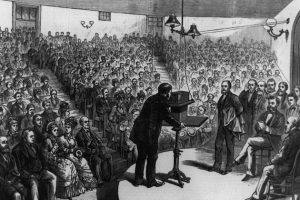In the mid-nineteenth century, the United States was a rapidly changing society. Many Americans were excited by the new possibilities available through the growing population and economic complexity of the time. Others, however, were not as thrilled with the challenges against the traditional values and institutions, along with social instability, inequality, and uncertainty of the future, brought about during this time. This period was called the Antebellum Era. Marking the time before the Civil War and after the War of 1812, the Antebellum Era called for self discovery and reformations that shaped American society.1

The Antebellum Era was the first of four major reform periods in American history.2 One reform in particular that has shaped human rights and rehabilitation is the Prison and Asylum Reforms of the 1830s. The creation of asylums, for criminals and for the mentally ill, was society’s reaction to the overcrowded and inhumane state that criminals of all varieties—debtors, the mentally ill, and even senile paupers—were automatically sectioned to.3 There were many individuals that took charge in leading this reform; one of these reformers was Dorothea Dix.
Dorothea Dix was born on April 4, 1802 in Hampden, District of Maine, Massachusetts. Growing up, Dix had a very difficult childhood. She rarely saw her father, who was a traveling Methodist preacher and writer of tracts, and her mother was often too ill to give attention to the children. Unhappy at home, Dix moved in with her grandmother at the age of twelve, where academic and social discipline were insisted upon. After two years, she was sent to live with her great aunt, where she found her permanent home. Dix soon after opened a school for small children that became successful. After returning to Boston, she opened a school for girls two years later. During the 1820’s Dix became ill with tuberculosis. While recovering from the illness, she became very interested in Unitarianism and the ideas of William Ellery Channing.4 In 1841, she was asked to teach Sunday School for women at the East Cambridge Jail. Upon her arrival she witnessed the innocent and guilty, young and old, sane and insane individuals crowded into an unsegregated group. There was no distinction between the mentally ill and those convicted of a crime. Dix instantly felt that something needed to be done. Dix sought after the help of other reformers, such as Samuel Gridley Howe and Charles Sumner, to guide her as she embarked on this journey. She began surveying hospitals for the insane in Massachusetts. Most of the mentally ill were living in poorhouses or jails, chained, and subjected to horrendous conditions. Dix met up with some of the most renowned doctors in order to search for a humane alternative treatment. After several months, Dix wrote a petition to the Massachusetts Legislature.5
Dorothea Dix’s petition called for psychiatric hospitals to work to cure diseased minds on a foundation of kindness and respect. The creation of asylums was to help rehabilitate and reform mentally unstable patients. Many of the mentally ill were moved out of the jails and were placed in these asylums. Dix continued to work towards improving the care of the mentally ill, which was her primary focus, as she expanded her efforts to prison reform, which she pursued soon after her work on asylum reform.6 Asylum and Prison reforms, still topics of importance today, have changed drastically from the era of Dorothea Dix’s reforms. Dix’s movement for the creation of asylums sparked the reforms of such institutions across the world, causing wholesale reevaluations of current institutions and the adoption of more appropriate facilities for the betterment and care of the mentally ill. Dix’s vision set noble goals for penitentiaries and mental institutions across the nation, which are still challenges we are trying to live up to today. Dorothea Dix’s reform were part of a larger movement of reform in the Antebellum Era, reforms that included reforming gender roles as well as the major reform movement of the era, abolitionism.
- Alan Brinkley, American History: Connecting with the Past Volume 2, 15 edition (New York: McGraw-Hill Education, 2015), 315. ↵
- The second wave of reform was at the end of the nineteenth century (The Progressive Era); the third wave was the period of the New Deal in the 1930s, and the fourth wave was the Civil Rights Era of the 1950s and 1960s. ↵
- Brinkley, American History: Connecting with the Past Volume 2, 326. ↵
- Salem Press Encyclopedia, January 2016, s.v. “William Ellery Channing,” by James W. Oberly. ↵
- Salem Press Biographical Encyclopedia, January 2016, s.v. “Dorothea Dix,” by Fred R. Van Hartesveldt. ↵
- Salem Press Encyclopedia, September 2013, s.v. “Prison Reform,” by Kathy Warnes. ↵


40 comments
Jackie Velasquez
I was never informed of who Dorothea Dix was and her importance of the Antebellum Era. However after reading this article, I am glad she noticed something was wrong and that something had to be done. She went out of her way to look for doctors for not herself, but to help others and that was a powerful move for her. She is an inspiration and her decision has not gone unnoticed. Another fact I thought was interesting was that she opened schools and they were successful.
Lesley Martinez
I am a big fan of American history and really enjoyed reading this article! Reading about the reasons, such as the overcrowding and inhumane state of criminals, that led to the Prison and Asylum Reforms of the 1830s is captivating. Dorothea Dix’s drive to help those in the jail she taught Sunday School, even after having to move from home to home and being diagnosed with tuberculosis, demonstrates her generosity. Great article!
Vania Gonzalez
Wow this article is amazing I had no idea that the Antebellum era even existed. This really helped many peoples lives who were mentally ill and they had not created those asylums then those that were sick and those who had committed crimes would have no distinction between them which is completely wrong. This was a very informational article and very interesting to read about this era and how it changed the way mentally ill people are seen.
Briana Montes
I was never aware of the Antebellum era before to reading this article. I cant imagine how much more mentally ill patients suffered before psychiatric hospitals. The way they were being treated was cruel and very wrong. Dorthea Dix is a very nice person for putting all her effort in making the conditions better for the mentally ill. Very inspiring story and very good read and well written.
Thalia Romo
This article is really interesting because it shows that Dorothea Dix put effort and research into her ideology and didn’t just preach for it to happen. Although America was undergoing many changes throughout the early reform periods, some institutions/ideas didn’t follow with the growing population size. It’s interesting to see that Dorothea always had a caring heart from her starting up school for girls, to helping reform institution’s (more specifically asylums and prisons) across the United States. Maranda Avina does a fantastic job at constructing her article to keep me engaged with Dorothea’s ideas.
Felicia Stewart
From United States History, I was available with the Antebellum era and the prison and asylum reform prior to reading this article. I actually find these subjects to be very interesting which is what sparked me to read the article. As a psychology major this subject has always been of interest to me, especially the asylum reform, and how it changed the foundation for many. Dorthea Dix stood up and changed the lives of many people who were mentally ill and they were just thrown into these jails and treated the same as any other person. These people did not receive treatment for their illness and had to deal with inhuman treatment.
Samantha Ruvalcaba
I really enjoyed how you described Dorothea Dix’s character in this article. From the beginning, I could tell that she cared for and valued the basic rights of individuals. I once visited the Eastern State Penitentiary where they once kept criminals and the mentally ill together. I’m sure Dix’s reform, along with others had to do with the reformation of the prison–and eventually its shut down.
Maria Martinez
I had never heard of the prison and asylum reforms or Dorothea Dix, but I did know that there was a time where the mentally ill were mistreated and neglected by society. The fact that Dorothea Dix decided to take on the challenge of becoming the voice for those who were not able to speak out due to mental illness when she did not need to is inspiring and admirable. The reforms that took place were a major step towards the right direction for America in the battle towards equality for everyone, even those who are struggling with their mental health.
Tala Owens
I did not know of Dix before this article but I’m glad thank I know about her now. She is definitely someone to respect. She saw how these people where just being thrown into jails all together and there was no clear divide between the mentally ill and those who were criminals. She seems like a genuinely nice and caring person who took matters into her hands. She saw that reform needed to happen and she did everything she could to make sure it happened.
Diego Terrazas
I was never aware of the Antebellum era prior to reading this article. I cannot imagine how much more mental affliction mentally ill patients suffered before psychiatric hospitals. The way they were being treated was inhumane. Dorthea Dix is a true kind soul for putting all her effort in bettering the conditions for the mentally ill. Even today I hear about stories of mistreatment of the mentally ill, which is truly heartbreaking.